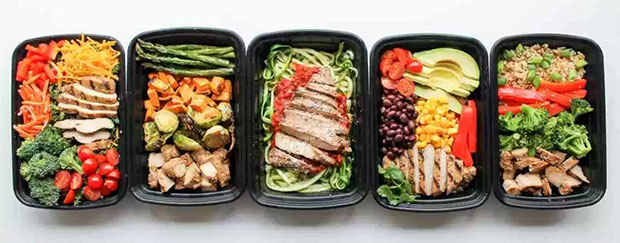Meal Prep 101
Looking for a convenient way to build nutritious and delicious meals into a busy schedule? Try meal prepping!

Of course, log onto any social media platform and you’re bound to encounter thousands of perfectly curated photos of elaborate meals. Getting into a habit of meal prepping doesn’t have to be time consuming, expensive, or elaborate; on the contrary, it should save you time, money, and allow you to build simple meals to enjoy during the week. Here are some tips to get you started.
Start With the Basics
Think back to high school health class. Remember My Plate? My Plate is composed of five food groups; fruits, vegetables, grains, proteins, and dairy (or dairy alternative – think calcium-containing foods). [note that fats are also an essential component of the diet] A good principle for meal planning is including as many food groups in each meal as you can, so that you receive the various nutritional benefits each provides. Aim to have at least three food groups in each meal and at least two food groups in a snack. An example would be having a meal containing chicken (protein), brown rice (grain), and collards (vegetable).
Another basic? Choosing your containers. They do not have to match or be fancy. Glass is nice because it doesn’t hang onto stains or odors, but it’s heavier than plastic or silicone options. Using what you have is always a budget friendly choice and you can upgrade later if you find your existing set isn’t doing the job.
Timing Matters
Some foods are longer lasting than others; for example, you wouldn’t buy fresh fish at the store and wait a week to eat it. Keep the same idea in mind when meal prepping; some foods are best eaten in the first few days while others may be robust enough to wait to prepare later in the week. Plan to eat delicate greens like baby spinach, bok choy, or green leaf lettuce early in the week; save heartier greens like kale for later in the week. Delicate ripe fruits like berries or peaches should be enjoyed quickly, while fruits like apples, pears, grapes, or citrus keep well in the fridge.
Prepared foods are best eaten within 3-4 days for food safety and quality. This means that you probably don’t want to prepare seven days’ worth of meals in one day, unless you plan to have some less-than-fresh options. A good plan is to start with one day per week and prepare 1-2 recipes that you will be able to eat within 3-4 days (say, one recipe for lunch and one for dinner). Once you have established a routine, pick a second day to do an additional meal prep for the latter half of the week.

No Limits
Just as some foods are best consumed quickly, some are designed to keep on hand a bit longer. Processed foods get a bad rap for long ingredient lists and additives, but food processing gives us the ability to make fresh foods last longer. Canned beans, corn, green beans, and other vegetables have similar nutritional value as fresh and can make it easier to have vegetables available to round out a meal when fresh groceries are scarce; buy low or no sodium versions. You can also rinse canned beans and vegetables to remove about 40% of the sodium present in the product.
Frozen foods are another option where nutrition is preserved with minimal additives; we are talking fresh frozen vegetables, fruits, and meats without added flavors or seasonings. Stock up on frozen vegetables to make meal prep or cooking for one easier and more budget friendly; simply grab a handful of the vegetable you need and keep the remainder in the freezer for later. Many grocery stores will also sell frozen pre-cut or chopped vegetables or mixes like peppers and onions to reduce your time in the kitchen. Frozen chopped fruit can be added to smoothies, yogurt, or eaten as a snack, and will last longer than fresh fruit in the fridge.
Fresh produce is always a nice addition to your plate; just keep in mind that frozen or canned items can make it possible to include fruits and vegetables in your meal when fresh isn’t an option.
Tailor it to Your Needs
Ask yourself a few questions to come up with the best meal prep plan for you. Some ideas:
- On what days or meal times do you lack time to prepare a meal?
- What day of the week do you have time available to cook in a leisurely way?
- What are your favorite types of meals to eat?
If you have fairly simple tastes for certain meals – say, you enjoy quick cooking oatmeal for breakfast most mornings or a sandwich or wrap for lunch – those may not be meals where you could save much time by cooking in advance. But don’t forget that meal prep doesn’t have to be for dinner; freezer breakfast burritos, overnight oatmeal, or jarred salads can be great options for breakfast or lunch that lend well to preparing in advance. You also don’t need special recipes; you can prepare familiar favorites and just portion them out purposefully. Chilis, soups, pasta bakes, curries, and stir fries can all be made in advance and their flavors even improve by the next day. Check out the UHC Nutrition Kitchen recipe archives for plenty of meal ideas.
Written by: Beth Kindamo, Nutrition Education Coordinator, UHC Health Promotion
